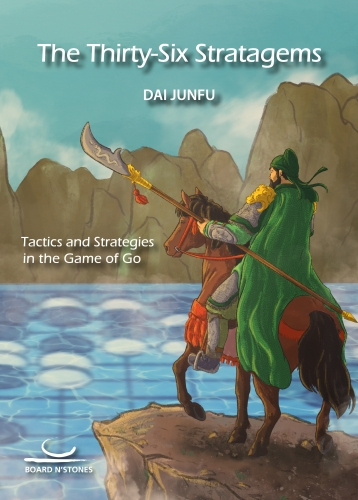By the way, this year the "BOARD N'STONES" publisher released Dai Junfu's Thirty-Six Stratagems series compiled into a book.

Written by Dai Junfu 8d
Born in 1983 in Shanghai, China. Learned go at the age of six.
Living in France since 2007.
Six-time French Champion and eight-time winner of the Paris Meijin.
Author of French go books Chûban (2010), Yose (2013) and L'Esprit du go (2022).
Thirty-Six Stratagems is a famous Chinese essay. It was written during the Southern Song Dynasty (420-479 CE) by Tan Daoji (died 436 CE), who was a high-level general of the army. This essay encompasses a series of stratagems – cunning and deceptive strategies used in warfare. It is a military publication considered to be on par with the Art of War by Sun Tzu.
Thirty-Six Stratagems is organized in six chapters. In each chapter six stratagems are presented, each accompanied by an anecdote from Chinese history.
Chapter 1: Stratagems When in a Superior Position.
Chapter 2: Stratagems for Confrontation.
Chapter 3: Stratagems for Attack.
Chapter 4: Stratagems for Confused Situations.
Chapter 5: Stratagems for Gaining Ground.
Chapter 6: Stratagems for Desperate Situations.
Besides their military use, the thirty-six stratagems have been recognized as valuable in other fields. There are hundreds of books on their application in daily life, business and politics. In the 1990s, two-time world go champion Ma Xiaochun 9p published a book that relates go to these ancient strategies.
It is a great honor for me to present the thirty-six stratagems to the go community in this journal. Each month I share with you a new stratagem from my own perspective, with examples from real games, some my own, that strike me as particularly fitting. I hope you enjoy and that these articles inspire you to improve your game.
This series was published as a book in 2024: Le Go en trente-six stratagèmes (French) and The Thirty-Six Stratagems (English).

Chapter 6. Stratagems for Desperate Situations
Stratagem 3. “Let the Enemy’s Own Spy Sow Discord in the Enemy Camp”
If you want to mislead your enemy, the best way is to feed them the wrong information –ideally from someone they trust, such as their own spy.
During the war of Chibi (208 CE), Cao Cao, the legendary warlord from the north, sent Jiang Gan, a childhood friend of Zhou Yu (the general of Wu army) to convince him to surrender. Zhou Yu sought to exploit the situation: he organised a banquet to receive his guest and then pretended to drink excessively. After the banquet, Zhou brought Jiang to his room to rest. Feigning drunkenness, Zhou told Jiang, “my spies in Cao Cao’s camp will soon offer me the head of Cao”, blacked out and slept deeply.
Jiang Gan thought he had chanced upon some vital information and scoured the documents on Zhou Yu’s desks. He finally found a letter from Cai Mao, a general who had recently joined Cao Cao’s camp. In the letter, Cai wrote that he disliked Cao Cao’s arrogance and felt badly treated as a new member of the group. Most importantly, he intended to join the Wu camp by offering the head of Cao Cao. Jiang Gan was so pleased with his discovery that he immediately crossed the Yangtze River under the cover of night with the fake letter that Zhou Yu had prepared intentionally.
After reading the letter, Cao Cao was so angry that he ordered Cai be killed on the spot. Shortly after, Cao realized he had been trapped by Zhou Yu, but his most experienced naval general was already dead. Cao was forced to delay his plans of attacking Wu, since no one in his company was qualified enough to train his naval troops. He had been given false information by his own spy.
In games of go, this kind of stratagem can be applied when a probe is played with the purpose of gaining benefits, but the other player is able to profit from it and causes extra damage to the opponent in the process. Let’s take a look at the example below.
Dia. 1. White’s probe
This board position is taken from the game between Ding Hao 9p (Black) and Fan Tingyu 9p (White) played in the Chinese A League on the 9th of August 2022.
White’s most recent move, circled in this diagram, aims at saving the three squared stones. It also tests Black’s reaction – the latter seems to have the choice only between A and B. According to Black’s response, White can adapt his plan.
Dia. 2. White escapes
If Black blocks at 1, White 2 is a tesuji. After White 4, Black A cannot separate the white stones, since White B creates a potential ladder. Later White C becomes a sente move, threatening to kill the corner – big endgame and annoying for Black. Black loses all his potential territory in this area compared to the previous diagram.
Dia. 3. White’s success
If Black plays 1 here instead of 3 in Dia. 2, White 2 and 4 make pleasing shape. Later, A and B are miai. This result is a success for White, also.
Dia. 4. White’s spy brings profits
If Black choses to compromise at 1, this is already a territorial loss and White can play elsewhere. Later White can play a crosscut at 2: after Black 3, White 4 breaks into Black’s territory – Black can’t respond at A because of the cutting point at B. If Black plays 3 at A, White C creates a position identical to the previous diagram.
Dia. 5. The counter-probe
In the actual game, Black’s counter-probe at 1 was a splendid move!
If White simply defends at 2, Black 3 and 5 are sente. Black 7 then attacks White on the left. Even though White can still escape with 8 and 10, Black’s connection at 11 is sente, threatening to cut off White’s stones at A.
Black significantly extends his influence in the center, this result is good for him.
Dia. 6. Prison break
This diagram explains why Black 5 in the previous diagram was sente. If White ignores that move, for example by playing 1 in this diagram, Black 2 to 6 nets White’s key stones and saves all the black stones in White’s territory.
Dia. 7. Black’s center is too large
If White plays atari at 1 after Black 5 in Dia. 5 to have a more comfortable connection with the stones on the left, Black 4 to 8 profits from the attack and Black 10 then encloses the entire central part of the board. White’s gain from saving the stones on the left is far less than Black’s tremendous gain in the center.
Dia. 8. White’s counterattack
White will have trouble counterattacking in response to Black 1 in Dia. 5. If he plays as shown in this diagram, Black’s crosscut at 2 is a tesuji: even though White 3 and 5 capture this stone, Black 8 threatens with A to kill the triangled white stone and with B to create a complicated capturing race with the white group below. If White 3 is played at 6 instead, Black C, White 7 and Black D allows Black to run out from the lower side and entangle the whole squared white group in the fight. White finds himself in a very difficult situation.
Dia. 9. Actual game, Part I: White’s shape weakened
In the actual game, White resisted at 1. After the exchange of 4 for 5, White’s shape in the middle is squeezed. Black attacked the white group on the left and after Black 16, White still has a weakness at A.
Dia. 10. Actual game, Part II: White’s disaster
In the continuation of the game, White lost his calm and counterattacked his opponent. White 3 led to an all-out nightmare. Black broke into the lower side with 14 and 16, preparing a capturing race. After Black 26, White was forced to spend many moves to capture the black stones on the lower side; his territory was significantly reduced and he lost the game shortly after.
As we see, Black turned White’s probing stone at A against him, drawing White into a complicated battle and ultimately seizing victory. White’s undoing was his own spy.
Here are the conditions for succeeding with this kind of stratagem:
- Your opponent’s probe is hard to answer directly
- There is aji or weakness in your opponent’s shape nearby
- Test your opponent’s reaction before reacting yourself, turning the probing move into a weakness of its own.









